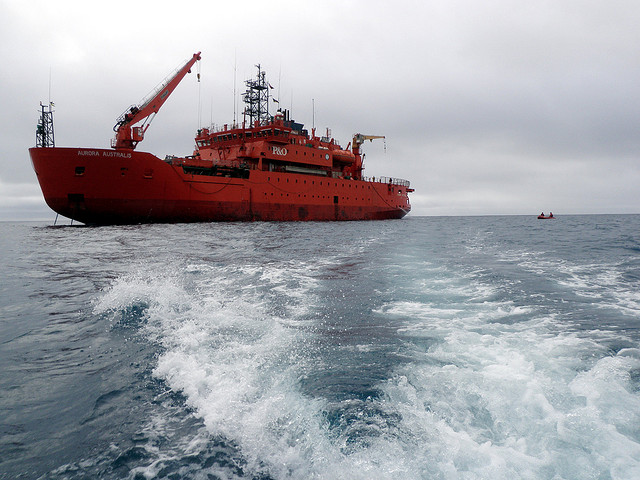 Earlier this year, I cited the case of the tourist expedition ship Akademik Shokalskiy, which became entrapped near Commonwealth Bay in the waters of Australia’s Antarctic Territory, as showing up serious limitations of Australia’s weakening search-and-rescue capabilities down south: our one polar vessel couldn’t reach the Shokalskiy. Nor was it carrying helicopters that could.
Earlier this year, I cited the case of the tourist expedition ship Akademik Shokalskiy, which became entrapped near Commonwealth Bay in the waters of Australia’s Antarctic Territory, as showing up serious limitations of Australia’s weakening search-and-rescue capabilities down south: our one polar vessel couldn’t reach the Shokalskiy. Nor was it carrying helicopters that could.
In the recent federal budget, the government announced that it will request tenders for a new icebreaker to replace the ageing Aurora Australis. It’s a welcome move: Aurora Australis is approaching the end of its serviceable life. A decision was needed to commit to a replacement to ensure our ability to conduct marine research anywhere in the Southern Ocean at any time of year, and to provide a heavy-lift capability for efficient delivery of station cargo and refuelling.
Environment Minister Greg Hunt said two Europe-based firms had been shortlisted to build the vessel, to be delivered by 2019. Hunt told reporters that it will cost ‘hundreds and hundreds of millions’, but he wouldn’t comment further due to an ongoing tender process. The new ship will be a significant capability enhancement over the Aurora Australis, in terms of its icebreaking and cargo capacities.
In announcing the decision, Minister Hunt linked it directly to our polar sovereignty claim:
It is absolutely critical under international law for Australia to maintain an active presence in Antarctica so as to maintain our claims. We have about 42 percent of the Antarctic land mass which is covered by Australian claims and if we were to abandon that … then that would be a deeply irresponsible action for future generations.
But while the Minister’s decision to replace Aurora Australis is welcome, it’s only one part of the story when it comes to the maritime capabilities required for our southern backyard.
The Senate Foreign Affairs, Defence and Trade Committee is currently inquiring into Australia’s future activities and responsibilities in the Southern Ocean and Antarctic waters. In a joint submission to the Committee, Sam Bateman and I argue that Australia requires ships capable of operating in the Southern Ocean and off the coast of Antarctica for surveillance, patrol and response (for sovereignty protection, law enforcement and search and rescue); marine scientific research; and the logistic support of Australia’s Antarctic program. In the longer term, a requirement may arise for warships with the necessary capabilities.
Response requires a surface vessel and that’s where we’re most seriously lacking at present. The requirement for the task will increase in the future: apart from our own national interests, the Southern Ocean contains valuable living resources including the largest underexploited fishery in the world, the Antarctic krill fishery.
Our current capability to respond to a safety-of-life-at-sea issue in southern waters is limited to three principal vessels: Ocean Protector, Ocean Shield, and Aurora Australis, and only the latter is ice-capable. RAN ships may be available, but none are ice-strengthened and only the fleet replenishment ships, HMAS Choules and the LHDs about to enter service, could undertake an extended search without the support of a tanker.
As noted above, in terms of marine research and logistics, with only one ageing Antarctic research vessel, we’re being left behind by other nations: China, Japan, the Russian Federation, South Korea and South Africa have each launched or announced new icebreakers.
And it’s over two years since we’ve had a patrol vessel in the Southern Ocean. We’ve relied on assistance from France, but that’s only available off the Territory of Heard and McDonald islands.
The concept of a ‘national fleet’ offers a possible approach to building the required capacity: rather than each agency doing its ‘own thing’ with blue water capabilities, there’s scope for a ‘whole of nation’ approach to address national requirements for those capabilities other than naval war-fighting. Along with the Senate Committee’s report, it might be useful to have an independent study into Australia’s requirements for blue-water capabilities for maritime policing, patrol and scientific research, including in the Southern Ocean and off Antarctica.
The national fleet concept might be considered in both the project to replace the Aurora Australis and Defence Project SEA 1180 to provide a class of around 20 Offshore Combatant Vessels (OCVs). Regarding the OCVs, the 2013 Defence White paper noted (at paragraph 8.56): ‘in the shorter-term, Government will seek to replace the current Armidale Class patrol boats with a proven vessel to ensure that Defence can continue to provide a patrol capability’ while a longer-term solution is considered.
It’s probable that the Armidale Class replacement will be an updated version of the Cape Class vessels being acquired by the Australian Customs and Border Protection Service. Such vessels would be unsuitable for operations in the Southern Ocean and off Antarctica. The requirement for operations in those waters should be considered in selecting the longer-term solution for the OCV.
Anthony Bergin is deputy director at ASPI. Image courtesy of Flickr user Natalie Tapson.

